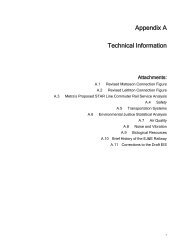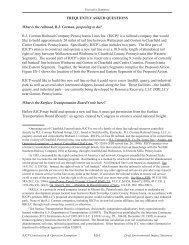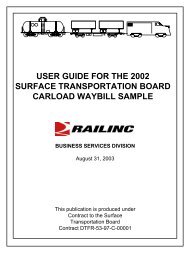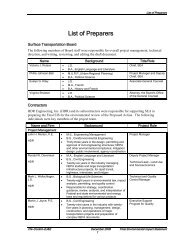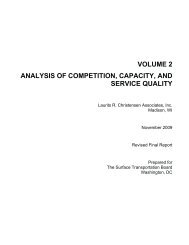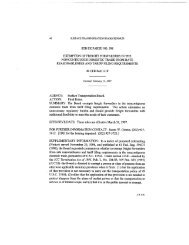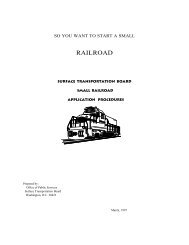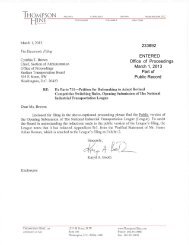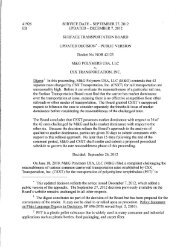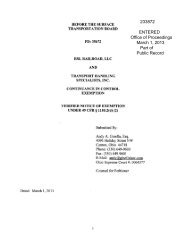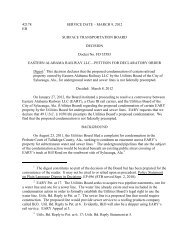BNSF - Surface Transportation Board
BNSF - Surface Transportation Board
BNSF - Surface Transportation Board
Create successful ePaper yourself
Turn your PDF publications into a flip-book with our unique Google optimized e-Paper software.
41621 SERVICE DATE – LATE RELEASE AUGUST 17, 2011<br />
EB<br />
SURFACE TRANSPORTATION BOARD<br />
DECISION<br />
Docket No. AB 6 (Sub-No. 476)<br />
<strong>BNSF</strong> RAILWAY COMPANY—DISCONTINUANCE—IN IRON AND CRAWFORD<br />
COUNTIES, MO.<br />
Digest: 1 <strong>BNSF</strong> Railway Company is permitted to terminate service over a<br />
46-mile line of railroad, known as the Lead Line, in Iron and Crawford Counties,<br />
Mo.<br />
Decided: August 17, 2011<br />
On April 29, 2011, <strong>BNSF</strong> Railway Company (<strong>BNSF</strong>) filed an application under<br />
49 U.S.C. § 10903 for permission to discontinue service over a 45.84-mile line of railroad known<br />
as the Lead Line (the Line), extending from milepost 87.60, at Cuba, Mo., to the end of the line<br />
at milepost 133.42, near Buick, Mo., 2 in Iron and Crawford Counties, Mo. Notice of the filing<br />
was served and published in the Federal Register (76 Fed. Reg. 29,030) on May 19, 2011. No<br />
protests against the proposed discontinuance were filed. We will grant the request for<br />
discontinuance authority, subject to standard employee protective conditions.<br />
BACKGROUND<br />
According to <strong>BNSF</strong>, the Line is contaminated with lead, and a former shipper, Doe Run<br />
Resources Corporation 3 (Doe Run), is the source of the contamination. <strong>BNSF</strong> states that the<br />
Line was embargoed on December 2, 2002, in order to conduct environmental remediation<br />
ordered by the State of Missouri at the Cuba Yard, which provides access to the Line. <strong>BNSF</strong><br />
explains that the embargo was extended as a result of subsequent environmental studies, which<br />
determined that additional remediation was needed to bring the Line into compliance with<br />
1 The digest constitutes no part of the decision of the <strong>Board</strong> but has been prepared for the<br />
convenience of the reader. It may not be cited to or relied upon as precedent. See Policy<br />
Statement on Plain Language Digests in Decisions, EP 696 (STB served Sept. 2, 2010).<br />
2 The line is 45.84 miles in length, not 45.82, because one of the segments is longer than<br />
the mileposts indicate. The line also has approximately 6.1 miles of sidings.<br />
3 <strong>BNSF</strong> refers to both Doe Run Resources Corporation and The Doe Run Company. We<br />
assume that they are related entities and refer to both as Doe Run.
Docket No. AB 6 (Sub-No. 476)<br />
Missouri state law. The embargo remains in effect, 4 and, as a consequence, there are no active<br />
customers on the Line.<br />
TRAFFIC, OPERATIONS, AND REVENUES<br />
<strong>BNSF</strong> provides base year carload and revenue data for the period January 2010 through<br />
December 2010, and forecast year carload and revenue data for the period April 2011 through<br />
March 2012. Because there were no freight operations on the Line during the base year, no<br />
freight revenues are attributable to the Line. For the forecast year, <strong>BNSF</strong> assumes that the same<br />
level of traffic that moved on the Line prior to the embargo would return to the Line, and it<br />
inflates the revenues by 3% per year. This results in forecast year carloads of 488 and revenues<br />
of $1,864,178 (which includes a small amount of revenue from leases and permits). <strong>BNSF</strong><br />
estimates the same traffic level and revenues for the projected “subsidy year.” 5 We will accept<br />
<strong>BNSF</strong>’s figures.<br />
AVOIDABLE COSTS<br />
Avoidable costs are costs that an applicant will cease to incur if it discontinues service<br />
over a line. <strong>BNSF</strong> submitted data showing avoidable on-branch costs for the base and forecast<br />
years. These include: maintenance-of-way and structures; 6 maintenance of equipment,<br />
including depreciation; transportation; freight car costs (other than return); return on valuelocomotives;<br />
and return on value-freight cars. <strong>BNSF</strong> reports total avoidable on-branch costs of<br />
$366,720 for the base year, and projects costs of $1,134,285 for the forecast year and the subsidy<br />
year. In addition, <strong>BNSF</strong> reports total avoidable off-branch costs of $0 for the base year and<br />
projects costs of $992,577 for the forecast year and the subsidy year. Total avoidable costs are<br />
$366,720 for the base year, and $2,126,862 for the forecast year and the subsidy year. We accept<br />
<strong>BNSF</strong>’s avoidable costs.<br />
LINE CONDITION AND REHABILITATION<br />
The application states that a number of <strong>BNSF</strong> employees and contractors have filed<br />
personal injury claims against <strong>BNSF</strong> alleging exposure to lead during the transportation of lead<br />
4 Prior to the embargo, the customers on the line were Doe Run; Solvay Minerals, Inc.;<br />
Penoles Metals & Chemicals; American Minerals, Inc.; Guardian Industries Corporation; Scott<br />
Tie Company, Inc.; Noranda, Inc.; and International Paper.<br />
5 The “subsidy year” is defined in our regulations as “any 12-month period for which a<br />
subsidy agreement for continued rail service has been negotiated and is in operation.” 49 C.F.R.<br />
§ 1152.2(m).<br />
6 We note that <strong>BNSF</strong>’s claimed maintenance of way cost of $8,000 per mile was not<br />
calculated as required by 49 C.F.R. § 1152.32 and 49 C.F.R. § 1152.33. While this error is<br />
immaterial here, we caution parties to ensure that the evidence submitted conforms to our<br />
regulations.<br />
2
Docket No. AB 6 (Sub-No. 476)<br />
concentrates over the Line. Multiple investigations, which were conducted by Applied<br />
Engineering & Science, Inc. and AECOM Environment (AECOM), revealed lead contamination<br />
on the Line. AECOM estimates that the remediation needed to reduce lead concentrations<br />
sufficiently to reopen the Line would cost, at minimum, $2,180,000. <strong>BNSF</strong> states that prior to<br />
reopening the Line, it would need to conduct additional investigations to ensure that the health of<br />
its employees and contractors would be protected. Such investigations could further increase the<br />
cost of remediating the Line.<br />
<strong>BNSF</strong> explains that no maintenance has been performed on the Line since the 2002<br />
embargo, and, consequently, numerous portions of the Line are out of service due to blocked<br />
drainage caused by falling rocks, washouts, defective ties, and paved-over crossings. <strong>BNSF</strong><br />
submits that, in addition to the lead remediation costs above, an investment of $23,818,000 to<br />
address maintenance deficiencies would be required to reopen the Line.<br />
We accept <strong>BNSF</strong>’s forecast and subsidy year costs of $25,998,000 for rehabilitation costs<br />
to reopen the Line.<br />
OPPORTUNITY COSTS<br />
Opportunity costs (or total return on value of road property) reflect the economic loss<br />
experienced by a carrier from forgoing a more profitable alternative use of its assets. Under<br />
Abandonment Regulations–Costing, 3 I.C.C.2d 340 (1987), the opportunity cost of road property<br />
is computed on an investment base equal to the sum of: (1) allowable working capital; (2) the<br />
net liquidation value (NLV) of the line; and (3) current income tax benefits (if any) resulting<br />
from abandonment. The investment base (or valuation of the road properties) is multiplied by<br />
the current nominal rate of return to yield the nominal return on value. 7 The nominal return is<br />
then adjusted by applying a holding gain (or loss) to reflect the increase (or decrease) in value a<br />
carrier will expect to realize by holding assets for 1 additional year.<br />
<strong>BNSF</strong> uses 15.58% to represent the pre-tax cost of capital for the railroad industry.<br />
<strong>BNSF</strong>’s actual calculation for determining the total return on value relies on three items: (1)<br />
working capital ($41,352); (2) the income tax consequences ($0); and (3) the NLV of its road<br />
property ($4,114,689). <strong>BNSF</strong> identifies no holding gain or loss. We accept <strong>BNSF</strong>’s opportunity<br />
cost of $647,511.<br />
SUMMARY OF COST AND REVENUE EVIDENCE<br />
For the entire line, in the forecast year, <strong>BNSF</strong> will realize revenues of $1,864,178 and<br />
incur avoidable costs of $2,126,862, resulting in a forecast year operating loss of $262,684.<br />
7 Under 49 C.F.R. § 1152.34(d), the rate of return used to calculate return on value<br />
represents the individual railroad’s current pre-tax nominal cost of capital. Our most recent<br />
after-tax cost of capital finding for the railroad industry is used as a basis for developing the<br />
appropriate nominal rate of return.<br />
3
Docket No. AB 6 (Sub-No. 476)<br />
When the total return on value is considered, the estimated forecast year loss from operations is<br />
$910,195. When the costs to rehabilitate the Line are considered, the estimated subsidy payment<br />
is $26,926,837. See the Appendix to this decision.<br />
ALTERNATIVE TRANSPORTATION<br />
<strong>BNSF</strong> claims that the remaining shippers have access to rail service by Union Pacific<br />
Railroad Company at nearby locations, and that competitive and effective motor carrier service is<br />
readily available. <strong>BNSF</strong> states that the former <strong>BNSF</strong> traffic has moved by truck during the<br />
embargo and that State Highways 19 and 48 run essentially parallel to the Line, while other<br />
highways run east-west through the area. <strong>BNSF</strong> points out that its former customers on the Line<br />
have been relying upon other rail and truck options, since they have not had access to its rail<br />
service since 2002.<br />
SHIPPER AND COMMUNITY INTERESTS<br />
No protests were filed expressing shipper or community concerns.<br />
DISCUSSION AND CONCLUSIONS<br />
The statutory standard governing an abandonment or discontinuance of service is whether<br />
the present or future public convenience and necessity permit the proposed abandonment or<br />
discontinuance. 49 U.S.C. § 10903(d). In implementing this standard, we must balance the<br />
potential harm to affected shippers and communities against the present and future burden that<br />
continued operations could impose on the railroad and on interstate commerce. Colorado v.<br />
United States, 271 U.S. 153, 168-69 (1926). Essentially, the <strong>Board</strong> must determine whether the<br />
burden on the railroad from continued operations is outweighed by the burden on shippers and<br />
the community from the loss of rail service.<br />
As stated above, for the entire line, in the forecast year, <strong>BNSF</strong> will realize revenues of<br />
$1,864,178 and incur avoidable costs of $2,126,862, resulting in a forecast year operating loss of<br />
$262,684. When the total return on value is considered, the estimated forecast year loss from<br />
operations is $910,195. When the costs to rehabilitate the Line are considered, the estimated<br />
subsidy payment is $26,926,837. See the Appendix to this decision.<br />
In contrast to the demonstrated burden that continued operation of the Line would impose<br />
on <strong>BNSF</strong> and on interstate commerce, the burden that the discontinuance would impose is<br />
minimal at best, given that the Line has not been used since 2002 and no shippers or community<br />
members filed protests against the discontinuance. Environmental remediation sufficient for the<br />
safety of employees and contractors and rehabilitation of the Line would require an expenditure<br />
that cannot be justified given the expected losses on the Line. We conclude that any harm to the<br />
former shippers and the community from the proposed discontinuance is outweighed by the<br />
demonstrated harm to <strong>BNSF</strong> and the burden on interstate commerce through continued operation<br />
of the Line. We will therefore grant the discontinuance application.<br />
4
Docket No. AB 6 (Sub-No. 476)<br />
LABOR PROTECTION<br />
In approving this discontinuance application, we must ensure that affected rail employees<br />
will be adequately protected. 49 U.S.C. § 10903(b)(2). The <strong>Board</strong> has found that the conditions<br />
imposed in Oregon Short Line—Abandonment Portion Goshen Branch Between Firth &<br />
Ammon, in Bingham & Bonneville Counties, Idaho, 360 I.C.C. 91 (1979), satisfy the statutory<br />
requirements, and we will impose those conditions here.<br />
ENVIRONMENTAL ISSUES<br />
No traffic will be diverted as a result of the proposed discontinuance, and <strong>BNSF</strong> will not<br />
be permitted to salvage the Line as the result of our decision in this proceeding. Therefore, an<br />
Environmental Report and a Historic Report are not required. The <strong>Board</strong> will require <strong>BNSF</strong> to<br />
file an Environmental Report and a Historic Report if <strong>BNSF</strong> seeks authority in the future to<br />
abandon the Line.<br />
Because this is a discontinuance proceeding and not an abandonment, interim trail<br />
use/rail banking, and public use requests are not appropriate. 8<br />
The <strong>Board</strong> finds:<br />
1. The present or future public convenience and necessity permit the discontinuance of<br />
service over the above-described Line, subject to the employee protective conditions set forth in<br />
Oregon Short Line.<br />
2. Discontinuance of service over the Line will not have a serious, adverse impact on<br />
rural and community development.<br />
3. This action will not significantly affect either the quality of the human environment or<br />
the conservation of energy resources.<br />
It is ordered:<br />
1. This application is granted, subject to standard employee protective conditions.<br />
2. <strong>BNSF</strong> must promptly provide any interested persons the information they require to<br />
formulate an OFA to subsidize rail service over the Line.<br />
3. An OFA under 49 C.F.R. § 1152.27(b)(1) to subsidize continued rail service must be<br />
received by the railroad and the <strong>Board</strong> by August 29, 2011, subject to time extensions authorized<br />
under 49 C.F.R. § 1152.27(c)(1)(i)(C). The offeror must comply with 49 U.S.C. § 10904 and<br />
8 The offer of financial assistance (OFA) provisions for a subsidy to provide continued<br />
rail service apply to discontinuances.<br />
5
Docket No. AB 6 (Sub-No. 476)<br />
49 C.F.R. § 1152.27(c)(1). Each OFA must be accompanied by a $1,500 filing fee. 49 C.F.R.<br />
§ 1002.2(f)(25).<br />
5. OFAs and related correspondence to the <strong>Board</strong> must refer to this proceeding. The<br />
following notation must be typed in bold face on the lower left-hand corner of the envelope:<br />
“Office of Proceedings, AB-OFA.”<br />
6. Provided no OFA to subsidize continued rail service has been received, this decision<br />
will be effective on September 16, 2011. Any petition to stay or petition to reopen must be filed<br />
as provided at 49 C.F.R. § 1152.25(e).<br />
By the <strong>Board</strong>, Chairman Elliott, Vice Chairman Begeman, and Commissioner Mulvey.<br />
6
Docket No. AB 6 (Sub-No. 476)<br />
APPENDIX<br />
Base Year<br />
operations<br />
Forecast<br />
year<br />
operations<br />
Projected<br />
Subsidy year<br />
operations<br />
Revenues attributable for:<br />
1. Freight originated and/or terminated on branch $0 $1,862,938 $1,862,938<br />
2. Bridge Traffic<br />
3. All other revenue and income $1,240 $1,240 $1,240<br />
4. Total revenues attributable (lines 1 through 3) $1,240 $1,864,178 $1,864,178<br />
Avoidable costs for:<br />
5. On-branch costs (lines 5a through 5k) $366,720 $1,134,285 $1,134,285<br />
a. Maintenance of way and structures $366,720 $366,720 $366,720<br />
b. Maintenance of equipment $11,559 $11,559<br />
c. <strong>Transportation</strong> $298,511 $298,511<br />
d. General administrative<br />
e. Deadheading, taxi, and hotel<br />
f. Overhead movement<br />
g. Freight car costs (other than return on freight cars) $332,634 $332,634<br />
h. Return on value-locomotives $120,516 $120,516<br />
i. Return on value-freight cars $4,345 $4,345<br />
j. Revenue taxes<br />
k. Property taxes<br />
6. Off-branch costs $0 $992,577 $992,577<br />
a. Off-branch costs (other than return on freight cars) $992,577 $992,577<br />
b. Return on value-freight cars<br />
7. Total avoidable costs(line 5 plus line 6) $366,720 $2,126,862 $2,126,862<br />
Subsidization costs for:<br />
8. Rehabilitation $25,998,000 $25,998,000<br />
9. Administration costs (subsidy year only) $18,642<br />
10. Casualty reserve account<br />
11. Total subsidization costs ( lines 8 through 10) $0 $25,998,000 $26,016,642<br />
Return on value:<br />
12. Valuation of property ( lines 12a through 12c) $0 $4,156,041 $4,156,041<br />
a. Working capital $41,352 $41,352<br />
b. Income tax consequences<br />
c. Net liquidation value $4,114,689 $4,114,689<br />
13. Nominal rate of return 15.58% 15.58%<br />
14. Nominal return on value ( line 12 times line 13) $0 $647,511 $647,511<br />
15. Holding gain (loss) $0 $0<br />
16. Total return on value (line 14 minus line 15) $0 $647,511 $647,511<br />
17. Avoidable loss from operations (line 4 minus line 7) ($365,480) ($262,684) ($262,684)<br />
18. Estimated forecast year loss from operations (line 4 minus<br />
lines 7 and 16) ($910,195) ($910,195)<br />
19. Estimated subsidy (line 4 minus 7,11, and 16) ($26,926,837)<br />
7




